prasad1
Active member
Urban slums, a reality of our times, house children in large numbers. And within these slums are those who call the streets their home. So what does being homeless mean for a child, and how does one effect change? Suma Ravi takes a look.

14-year-old Ravi, who calls the pavement near Goregaon patri in Mumbai his home, has recently seen a drastic change in his schedule. Instead of taking an early morning train to the nearest station with his friends and occupying an available bit of space to set up his shoeshine business, he now gets dressed to go to school.
Ravi is like thousands of children we see on our daily commute, but don’t notice. They live by doing menial chores during the day on pavements that double up as beds at night. Definitions are aplenty: the homeless are those who live on pavements, streets, in pipes, under staircases, in temples, mandaps, on platforms or in the open, and not in a ‘census house’ (a structure with a roof). The homeless population can be divided into two main categories: homeless families who either live alone or in communities, and homeless individuals who live singly. The majority of the homeless are migrants who move to big towns and cities looking for better opportunities. These are the people affected by evictions, displacement, runaways, domestic issues, communal clashes, natural calamities, misfortune, and physical and mental disabilities.
.......................
So how does one reach out to this extremely marginalized section of society?
CRY’s partner AAKAR works with one such community. AAKAR first establishes rapport with the community by engaging with the children. They organize games and educational activities to bring children together and build an interest in them to go to school. Simultaneously, they work with parents to motivate them to send their children to school. They also urge parents to take an active part in the educational process, and sensitize school staff to understand homelessness and the issues that these children face vis-à-vis registration in schools.
Children on the streets: Making a difference - Analysis - DNA

14-year-old Ravi, who calls the pavement near Goregaon patri in Mumbai his home, has recently seen a drastic change in his schedule. Instead of taking an early morning train to the nearest station with his friends and occupying an available bit of space to set up his shoeshine business, he now gets dressed to go to school.
Ravi is like thousands of children we see on our daily commute, but don’t notice. They live by doing menial chores during the day on pavements that double up as beds at night. Definitions are aplenty: the homeless are those who live on pavements, streets, in pipes, under staircases, in temples, mandaps, on platforms or in the open, and not in a ‘census house’ (a structure with a roof). The homeless population can be divided into two main categories: homeless families who either live alone or in communities, and homeless individuals who live singly. The majority of the homeless are migrants who move to big towns and cities looking for better opportunities. These are the people affected by evictions, displacement, runaways, domestic issues, communal clashes, natural calamities, misfortune, and physical and mental disabilities.
.......................
So how does one reach out to this extremely marginalized section of society?
CRY’s partner AAKAR works with one such community. AAKAR first establishes rapport with the community by engaging with the children. They organize games and educational activities to bring children together and build an interest in them to go to school. Simultaneously, they work with parents to motivate them to send their children to school. They also urge parents to take an active part in the educational process, and sensitize school staff to understand homelessness and the issues that these children face vis-à-vis registration in schools.
Children on the streets: Making a difference - Analysis - DNA
